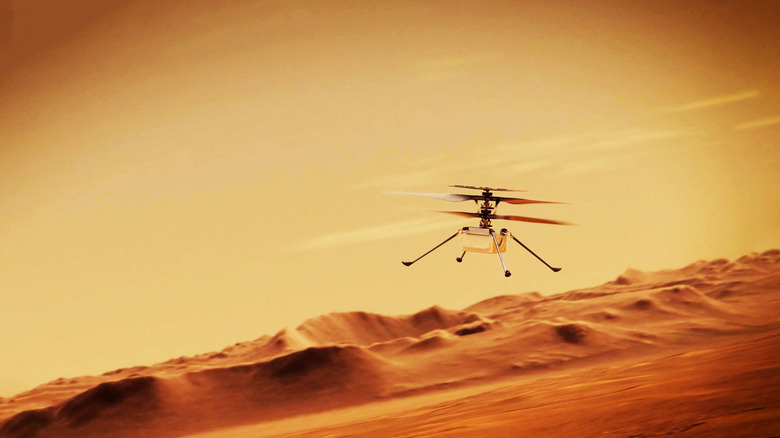What Happened To NASA's Ingenuity Helicopter From The Mars 2020 Mission?
In 2020, NASA launched the Ingenuity Mars Helicopter as part of its Mars 2020 mission, hitching the small rotorcraft aboard the Perseverance rover. The craft touched down on Mars' Jezero Crater on 18 February 2021 and was tasked with a daring test: demonstrate for the first time whether powered, controlled flight is possible in the atmosphere of the Red Planet.
Designed as a technology demonstration rather than an exploratory science vehicle, Ingenuity was expected to complete a handful of short test flights, no more than five sorties in about 30 Martian days (which are 37 minutes longer than Earth days). Its mission was to push the boundaries of aeronautics beyond Earth, proving that rotorcraft flight can one day be used for planetary exploration. Long story short, the mission was a success, but the story doesn't end here. Eventually, after an extended campaign far beyond its original scope, Ingenuity suffered a crash landing on Mars, bringing its flight operations to an end.
Ingenuity far exceeded its mission
The original plan for the Mars helicopter was modest. Following its first heroic flight on April 19, 2021, Ingenuity began to exceed every expectation. The mission statistics tell the story: instead of the five flights over roughly a month, the craft completed 72 flights in total. This extended mission lasted for over 1,000 Martian days, which is more than 33 times longer than initially intended. During that time, it logged more than two hours of cumulative flight time and traveled over 14 times the distance originally envisioned.
What did it achieve? With each sortie, Ingenuity explored new terrain ahead of the rover, gathered aerial images of the Martian surface, and served as a scout that helped plan the route for Perseverance. The early flights proved that a rotorcraft could fly in an atmosphere only about 1% as dense as Earth's. As the campaign continued, the helicopter ventured much farther and higher than originally planned. Each flight of Ingenuity helped open a new dimension of reconnaissance for planetary surfaces.
Then came the end of the small helicopter. On 18 January 2024, during its 72nd flight, Ingenuity executed its final landing. Subsequent imagery showed one of its rotor blades missing and other damage to the blade tips, signaling the end of its mission. An investigation by NASA's Jet Propulsion Laboratory later concluded that the craft's navigation system became confused while flying over mostly featureless sand-ripple terrain. Because it could not reliably detect surface details, the helicopter's velocity estimate drifted, leading to a harder-than-expected landing and rotor damage beyond design limits.
Ingenuity's legacy
The success of the Ingenuity Mars Helicopter has left a lasting legacy in both aeronautics and planetary exploration. By proving that powered flight on another planet is possible, Ingenuity opened a new method of probing planetary surfaces. In its role as an aerial scout for the Perseverance Rover, it helped map the Martian terrain ahead and obtain high-altitude imagery, all of which will help future missions.
Looking ahead, the Mars Chopper concept is already under development by NASA (via its Jet Propulsion Laboratory), Ames Research Center, and AeroVironment Inc. The Mars Chopper is envisioned as a much larger vehicle, about the size of an SUV, with six rotors. It will be capable of carrying science payloads of up to 11 pounds (~5kg) and flying nearly 2 miles (~3km) in a single Martian day. It aims to study terrain inaccessible to rovers, such as cliffs, deep craters, and dune fields.
The Mars Chopper is a future concept, and not an immediate replacement for Ingenuity. That's because the design of rotorcraft for Mars remains complex. The thin atmosphere, the autonomy, terrain navigation, communication delays, and dusty conditions all pose engineering challenges. Ingenuity was primarily a technical demonstration. Having proved that concept, NASA can now afford to invest in more capable craft, albeit at a higher cost and complexity. Moreover, mission planning must align with larger Mars science priorities and launch windows. In this way, Ingenuity's legacy is not just the flights it made, but the door it opened to aerial exploration of other worlds.


